
South Africa Greylisted - Here is what it means to be greylisted
South Africa has been added to the greylist by the global finance watchdog Financial Action Task Force (FATF). The FATF announced the decision on Friday afternoon following a five-day plenary meeting in Paris.
The decision means South Africa has been placed on a list of high-risk or non-compliant parties with respect to financial transactions. This can occur for various reasons, including concerns over money laundering, terrorism financing, or other illegal activities.
FATF will increase monitoring on the country and work together to address apparent strategic deficiencies in its regimes designed to tackle financial crimes.
SA was given until November 2022 to prove it is remedying the country’s structural deficiencies when it comes to anti-money laundering and countering the financing of terrorism. FATF members voted for SA to be greylisted following its failure to demonstrate satisfactory progress on these remedial actions.
The rand has been hit hard by the long-expected confirmation that South Africa was greylisted by the FATF.
The local currency was trading at R18.46/$ in early afternoon trading on Friday, the weakest level since November last year. It is closed to reaching levels last seen at the height of the pandemic crisis in May 2020.
Read | How to start a trucking company in South Africa – A beginner’s guide
Maarten Ackerman, chief economist and advisory partner at Citadel, says it’s possible that the rand could breach R19/$, and even weaker, in coming days.
The currency started the year at R17/$, but has come under pressure in recent weeks as the dollar rushed ahead as new US economic data supported more aggressive interest rate hikes, he adds.
The rand started bleeding on Thursday after meeting minutes from the Federal Reserve revealed an increased appetite for hikes.
“SA remains behind the US in the quantum of rate hikes so far, with only a 375 basis points lift in the repo rate versus the 450 basis points lift in the Fed funds rate in the current hiking cycle, resulting in rand weakness as SA’s risk premium with the US has eroded severely,” says Annabel Bishop, Investec economist.
If South Africa’s interest rates are not raised in step with the US, the rand and local assets like bonds will lose their appeal to foreign investors, who are on the hunt for good returns. Foreign inflows are crucial to keep the rand stable.
Greylisting is also negative for foreign inflows. Countries on the grey list have historically seen a decline in foreign investment.
Being on the grey list signals to global banks, financial institutions and foreign investors that the country is not fully compliant with anti-money laundering and terrorist financing standards.
Greylisting is expected to hike the cost of doing business in South Africa by increasing the amount of due diligence companies have to carry out. South Africans may also find sending funds offshore and transacting with international banks more onerous.
The dollar rally is also expected to lose some steam as the US interest rate hike cycle ends, with “peak dollar” expected in the first half of the year.





